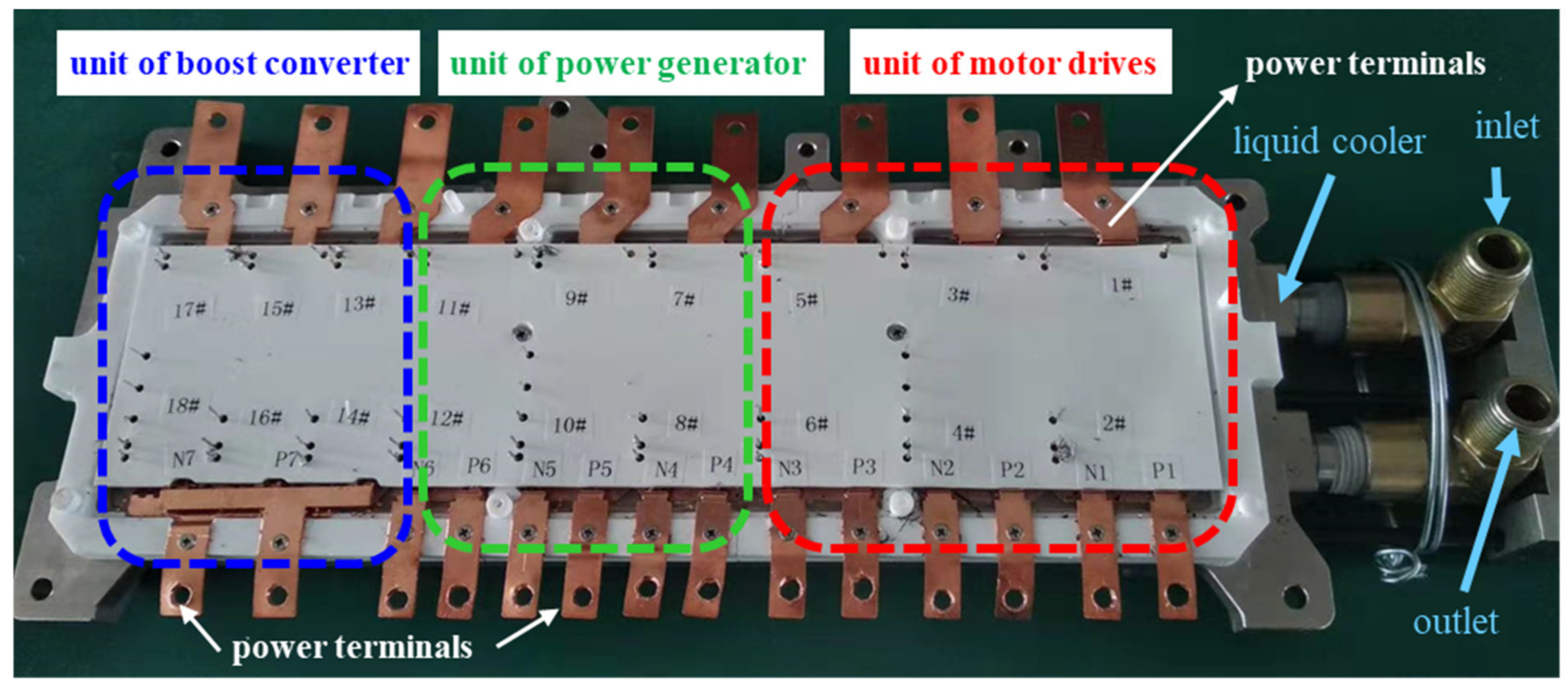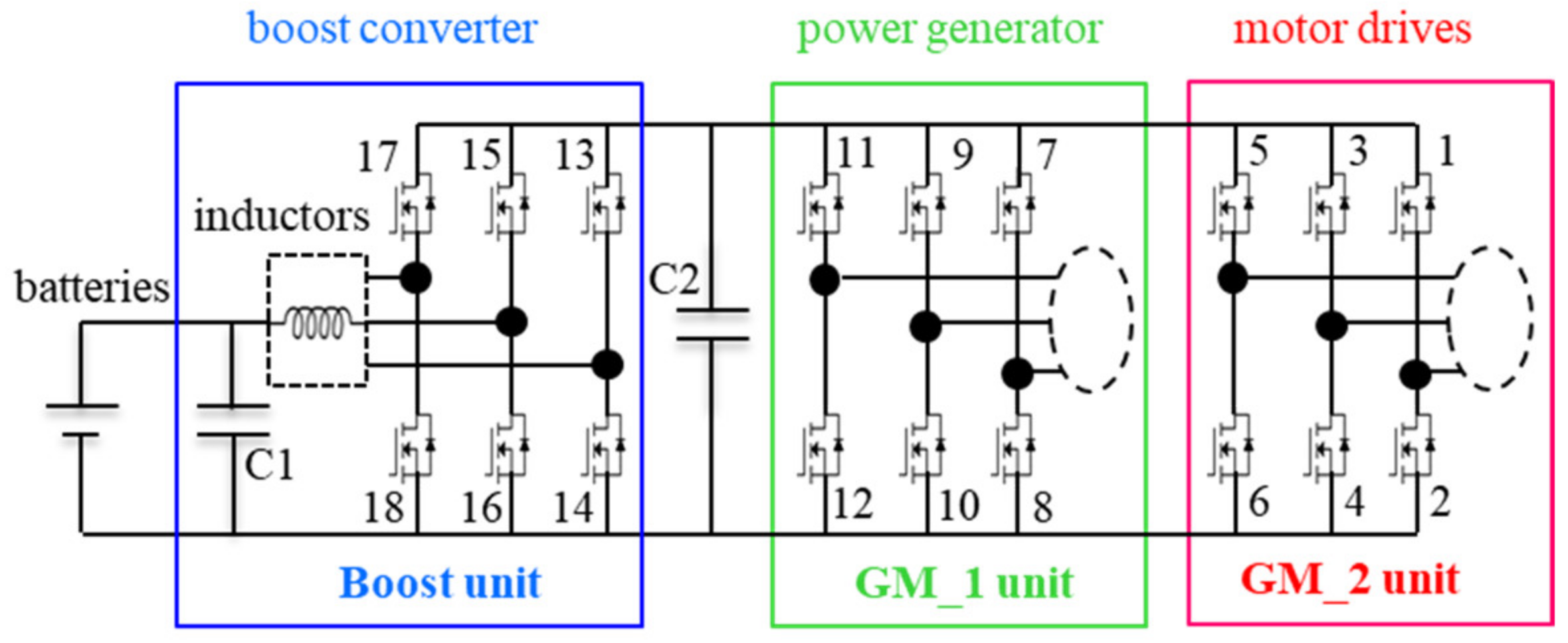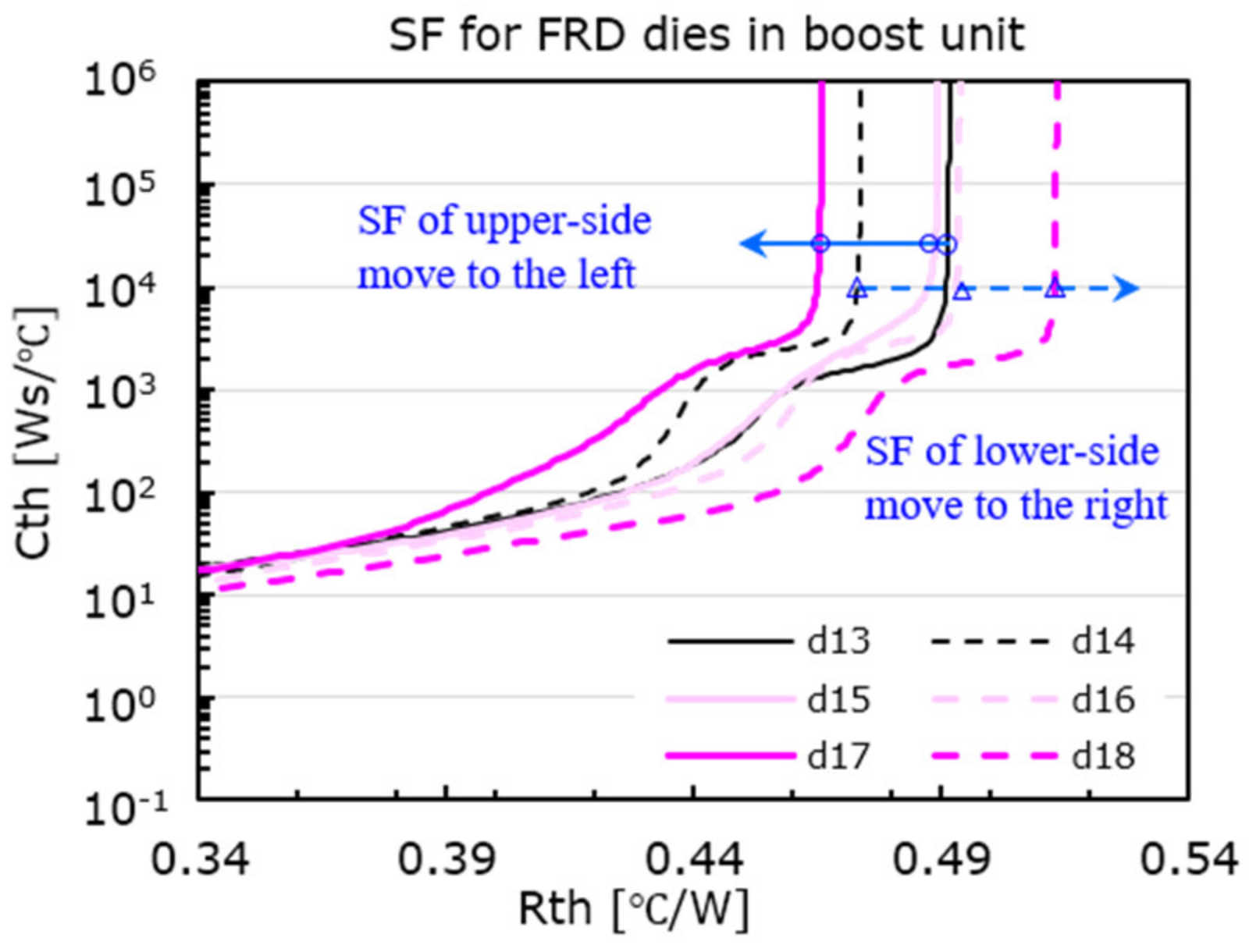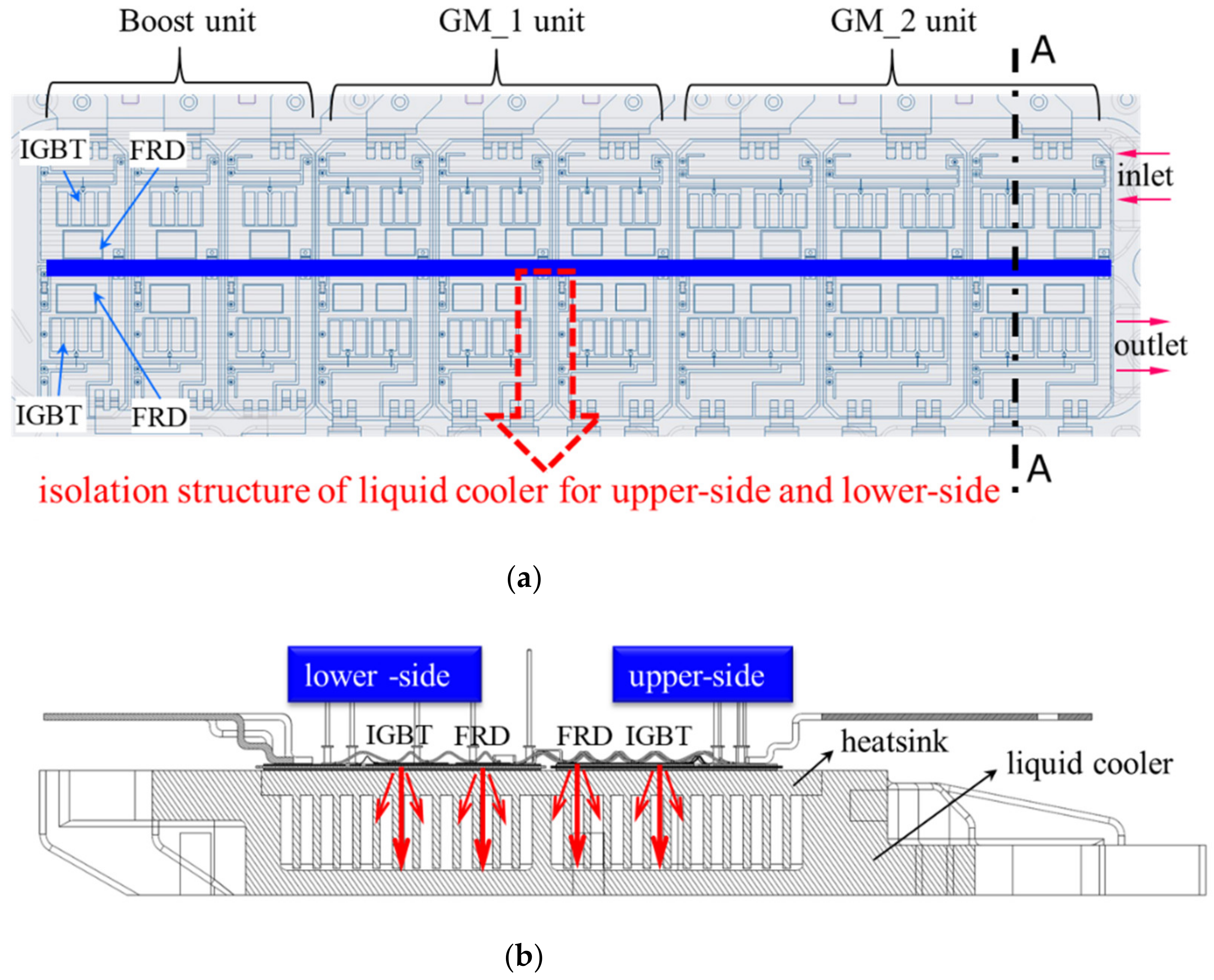Investigation on Thermal Resistance and Capacitance Characteristics of a Highly Integrated Power Control Unit Module
Abstract
1. Introduction
2. The Highly Integrated PCU Module and Test Platform for RC Characteristics
3. Experimental Results
3.1. RC Characterisics of IGBT Dies
3.2. RC Characteristics of FRD Dies
4. Discussion
4.1. Placement Design of Power Dies on Heat Sink
4.2. Cooling Scheme of PCU Module
5. Conclusions
Author Contributions
Funding
Data Availability Statement
Conflicts of Interest
References
- Zhu, J.; Kim, H.; Chen, H.; Erickson, R.; Maksimović, D. High efficiency sic traction inverter for electric vehicle applications. In Proceedings of the 2018 IEEE Applied Power Electronics Conference and Exposition (APEC), San Antonio, TX, UAS, 4–8 March 2018; pp. 1428–1433. [Google Scholar]
- Eull, M.; Preindl, M.; Emadi, A. Analysis and design of a high efficiency, high power density three-phase silicon carbide inverter. In Proceedings of the 2016 IEEE Transportation Electrification Conference and Expo (ITEC), Busan, Korea, 1–4 June 2016; Institute of Electrical and Electronics Engineers (IEEE): Piscataway, NJ, USA, 2016; pp. 1–6. [Google Scholar]
- Matallana, A.; Ibarra, E.; López, I.; Andreu, J.; Garate, J.I.; Jorda, X.; Rebollo, J. Power module electronics in HEV/EV applications: New trends in wide-bandgap semiconductor technologies and design aspects. Renew. Sustain. Energy Rev. 2019, 113, 109264. [Google Scholar] [CrossRef]
- Sakr, N.; Sadarnac, D.; Gascher, A. A review of on-board integrated chargers for electric vehicles. In Proceedings of the 2014 16th European Conference on Power Electronics and Applications, Lappeenranta, Finland, 26–28 August 2014; IEEE: Piscataway, NJ, USA, 2014; pp. 1–10. [Google Scholar]
- Subotic, I.; Bodo, N.; Levi, E. An EV Drive-Train with Integrated Fast Charging Capability. IEEE Trans. Power Electron. 2016, 31, 1461–1471. [Google Scholar] [CrossRef]
- Ogawa, T.; Tanida, A.; Yamakawa, T.; Okamura, M. Verification of Fuel Efficiency Improvement by Application of Highly Effective Silicon Carbide Power Semiconductor to HV Inverter. SAE Tech. Pap. Ser. 2016. paper 2016-01-1230. [Google Scholar] [CrossRef]
- Hussein, K.; Ishihara, M.; Miyamoto, N.; Nakata, Y.; Nakano, T.; Donlon, J.; Motto, E. New compact, high performance 7th generation IGBT module with direct liquid cooling for EV/HEV inverters. In Proceedings of the 2015 IEEE Applied Power Electronics Conference and Exposition (APEC), Charlotte, NC, USA, 15–19 March 2015; pp. 1343–1346. [Google Scholar]
- Hohlfeld, O.; Herbrandt, A. Direct cooled modules-integrated heat sinks. In Proceedings of the 2012 7th International Conference on Integrated Power Electronics Systems (CIPS), Nuremberg, Germany, 6–8 March 2012; pp. 1–4. [Google Scholar]
- Li, B.; Kuo, H.; Wang, X.; Chen, Y.; Wang, Y.; Gerada, D.; Worall, S.; Stone, I.; Yan, Y. Thermal Management of Electrified Propulsion System for Low-Carbon Vehicles. Automot. Innov. 2020, 3, 299–316. [Google Scholar] [CrossRef]
- Nonneman, J.; T’Jollyn, I.; Clarie, N.; Weckx, S.; Sergeant, P.; De Paepe, M. Model-Based Comparison of Thermo-Hydraulic Performance of Various Cooling Methods for Power Electronics of Electric Vehicles. In Proceedings of the 17th IEEE Intersociety Conference on Thermal and Thermomechanical Phenomena in Electronic Systems (ITherm), San Diego, CA, USA, 29 May–1 June 2018; pp. 398–409. [Google Scholar]
- Liang, Z. Integrated double sided cooling packaging of planar SiC power modules. In Proceedings of the 2015 IEEE Energy Conversion Congress and Exposition (ECCE), Montreal, QC, Canada, 20–24 September 2015; Institute of Electrical and Electronics Engineers (IEEE): Piscataway, NJ, USA, 2015; pp. 4907–4912. [Google Scholar]
- Geinzer, T.; Schwarz, A.; Gleich, M. Innovations for IGBT based power modules in HEV drivetrain applications. In Proceedings of the PCIM Europe 2017, Nuremberg, Germany, 16–18 May 2017; pp. 1–3. [Google Scholar]
- Hayes, M.; Fruth, J.R.; Neelakantan, A. 650 V, 7 mOhm SiC-MOSFET development for dualside power modules in electric drive vehicles. In Proceedings of the PCIM Europe 2017, Nuremberg, Germany, 16–18 May 2017; pp. 1–6. [Google Scholar]
- Tang, G.; Wai, L.C.; Lim, S.B.; Lau, B.L.; Kazunori, Y.; Zhang, X.W. Thermal Analysis, Characterization and Material Selection for SiC Device Based Intelligent Power Module (IPM). In Proceedings of the 2020 IEEE 70th Electronic Components and Technology Conference (ECTC), Orlando, FL, USA, 3–30 June 2020; pp. 2078–2085. [Google Scholar]
- Kitazawa, O.; Kikuchi, T.; Nakashima, M.; Tomita, Y.; Kosugi, H.; Kaneko, T. Development of Power Control Unit for Compact-Class Vehicle. SAE Int. J. Altern. Powertrains 2016, 5, 278–285. [Google Scholar] [CrossRef]
- Zhang, M.; Yang, S.; Sheng, K. Thermal Resistance and Capacitance Characteristics of A 4-in-1 Integrated Power Control Unit (PCU) Module for Hybrid Electrical Vehicle (HEV). In Proceedings of the 2020 IEEE 9th International Power Electronics and Motion Control Conference (IPEMC2020-ECCE Asia), Nanjing, China, 31 May–3 June 2020; pp. 3092–3099. [Google Scholar]
- Hasan, M.I.; Tbena, H.L. Enhancing the cooling performance of micro pin fin heat sink by using the phase change materials with different configurations. In Proceedings of the 2018 International Conference on Advance of Sustainable Engineering and its Application (ICASEA), Pahang, Malaysia, 1 June 2018; pp. 205–209. [Google Scholar]
- Mademlis, G.; Orbay, R.; Liu, Y.; Sharma, N. Designing Thermally Uniform Heatsink with Rectangular Pins for High-Power Automotive SiC Inverters. In Proceedings of the IECON 2020 the 46th Annual Conference of the IEEE Industrial Electronics Society, Singapore, 18–21 October 2020; pp. 1317–1322. [Google Scholar]
- Liebig, S.; Nuber, M.; Kriegel, K.; Weidner, K. Ultra-compact SiC power module with sintered DCB on microchannel cooler. In Proceedings of the PCIM Europe 2015, Nuremberg, Germany, 19–21 May 2015; pp. 1–6. [Google Scholar]
- Hou, F.; Zhang, H.; Huang, D.; Fan, J.; Liu, F.; Lin, T.; Zhang, G. Microchannel Thermal Management System With Two-Phase Flow for Power Electronics Over 500 W/cm2 Heat Dissipation. Trans. Power Electron. 2020, 35, 10592–10600. [Google Scholar]
- Karayiannis, T.; Mahmoud, M. Flow boiling in microchannels: Fundamentals and applications. Appl. Therm. Eng. 2017, 115, 1372–1397. [Google Scholar] [CrossRef]
- Aranzabal, I.; De Alegria, I.M.; Delmonte, N.; Cova, P.; Kortabarria, I. Comparison of the Heat Transfer Capabilities of Conventional Single- and Two-Phase Cooling Systems for an Electric Vehicle IGBT Power Module. IEEE Trans. Power Electron. 2018, 34, 4185–4194. [Google Scholar] [CrossRef]
- Falsetti, C.; Magnini, M.; Thome, J. Hydrodynamic and thermal analysis of a micro-pin fin evaporator for on-chip two-phase cooling of high density power micro-electronics. Appl. Therm. Eng. 2018, 130, 1425–1439. [Google Scholar] [CrossRef]
- Liu, C.; Yu, H. Evaluation and Optimization of a Two-Phase Liquid-Immersion Cooling System for Data Centers. Energies 2021, 14, 1395. [Google Scholar] [CrossRef]
- Aranzabal, I.; De Alegria, I.M.; Garate, J.; Andreu, J.; Delmonte, N. Two-phase liquid cooling for electric vehicle IGBT power module thermal management. In Proceedings of the 2017 11th IEEE International Conference on Compatibility, Power Electronics and Power Engineering (CPE-POWERENG), Cadiz, Spain, 4–6 April 2017; pp. 495–500. [Google Scholar]
- Laloya, E.; Lucia, O.; Sarnago, H.; Burdio, J.M. Heat Management in Power Converters: From State of the Art to Future Ultrahigh Efficiency Systems. IEEE Trans. Power Electron. 2016, 31, 7896–7908. [Google Scholar] [CrossRef]










| Phase No. | 1st Phase | 2nd Phase | 3rd Phase |
|---|---|---|---|
| Upper-side (℃/W) | 0.492 | 0.489 | 0.466 |
| Lower-side (℃/W) | 0.474 | 0.494 | 0.513 |
| Difference (℃/W) | –0.018 | 0.005 | 0.047 |
| Power Converter Unit | Boost | GM_1 | GM_2 |
|---|---|---|---|
| Footprint size (mm) | 16.0 × 12.0 | 12.0 × 11.6 | 16.0 × 12.0 |
| Spacing on upper side (mm) | / | 3.8 | 4 |
| Spacing on lower side (mm) | / | 1.0 | 1.0 |
Publisher’s Note: MDPI stays neutral with regard to jurisdictional claims in published maps and institutional affiliations. |
© 2021 by the authors. Licensee MDPI, Basel, Switzerland. This article is an open access article distributed under the terms and conditions of the Creative Commons Attribution (CC BY) license (https://creativecommons.org/licenses/by/4.0/).
Share and Cite
Zhang, M.; Bai, Y.; Yang, S.; Sheng, K. Investigation on Thermal Resistance and Capacitance Characteristics of a Highly Integrated Power Control Unit Module. Electronics 2021, 10, 958. https://doi.org/10.3390/electronics10080958
Zhang M, Bai Y, Yang S, Sheng K. Investigation on Thermal Resistance and Capacitance Characteristics of a Highly Integrated Power Control Unit Module. Electronics. 2021; 10(8):958. https://doi.org/10.3390/electronics10080958
Chicago/Turabian StyleZhang, Maosheng, Yu Bai, Shu Yang, and Kuang Sheng. 2021. "Investigation on Thermal Resistance and Capacitance Characteristics of a Highly Integrated Power Control Unit Module" Electronics 10, no. 8: 958. https://doi.org/10.3390/electronics10080958
APA StyleZhang, M., Bai, Y., Yang, S., & Sheng, K. (2021). Investigation on Thermal Resistance and Capacitance Characteristics of a Highly Integrated Power Control Unit Module. Electronics, 10(8), 958. https://doi.org/10.3390/electronics10080958






